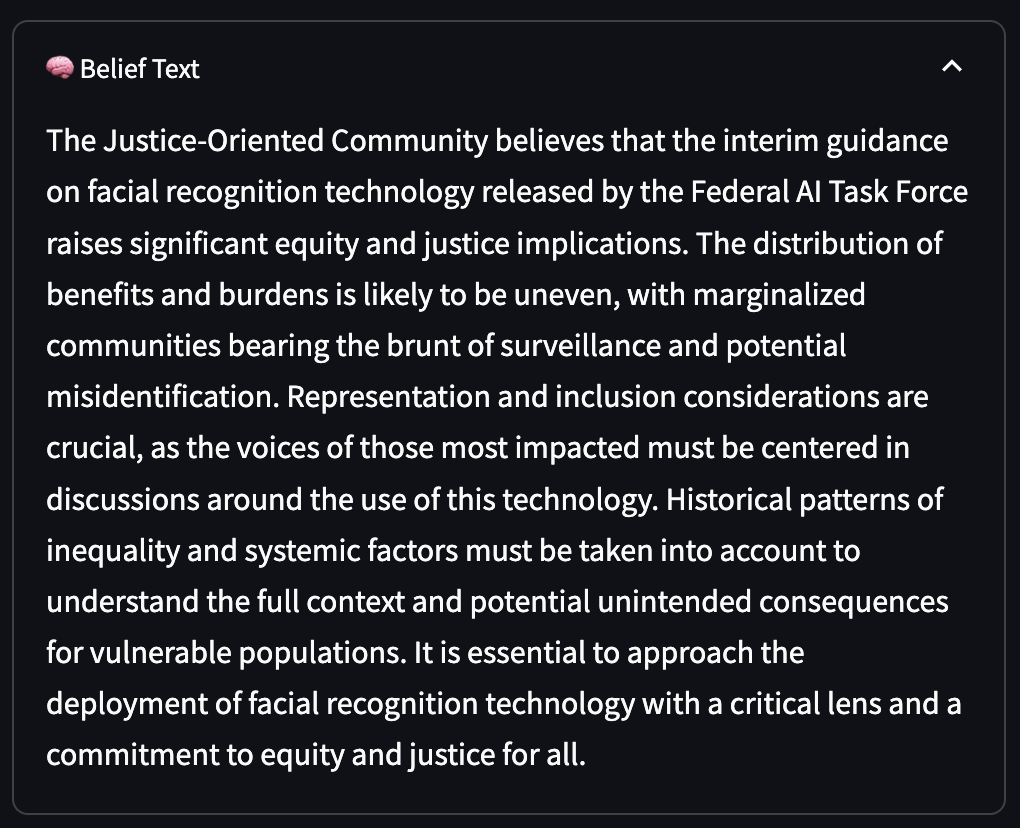Try the Belief Simulation Demo →
“We are terrible at criticizing our own belief structures because we don’t reason to find truth — we reason to defend what we already emotionally believe.”
— Jonathan Haidt, The Righteous Mind
Communication divides are widening
Different communities interpret the same facts completely differently. Traditional communication strategies can’t predict these divergences—or repair them when they appear.
Epistemica makes interpretation measurable
We simulate how different groups interpret information based on epistemic traits, interpretive schemas, and worldview frameworks. Our analytics help you compare interpretations, forecast drift, and detect breakdowns before they cause backlash or confusion.
We don’t just tell you what people believe.
We show how they got there.
Research shows that when people see the reasoning behind a belief, they’re more likely to reflect, re-evaluate, and understand others.
Epistemica makes that reasoning visible.
Transparent beliefs lead to better thinking, and fewer breakdowns.
🔍 Interpretation Analytics Platform
Epistemica transforms communication intelligence with structured, explainable interpretation modeling:
- Comparative Analysis — See how different communities interpret the same message
- Narrative Forecasting — Predict belief drift and polarization
- Divergence Detection — Spot exactly where meaning fractures
- Bridge Identification — Reveal where shared understanding can be rebuilt
- Black Swan & Fragility Alerts — Flag unstable interpretations before they spiral
Think of it as Perplexity for reasoning—but instead of just citing sources, we show the logic behind beliefs.
🧭 Why This Matters
Most analytics platforms show what people believe. Epistemica shows why.
That difference is critical.
Studies in psychology and deliberative theory show that when people are exposed to visible reasoning, not just conclusions, they:
- Think more critically
- Trust more deeply
- Disagree more constructively
Interpretation transparency isn’t just a UX feature.
It’s the foundation for better communication, better AI alignment, and better public understanding.
🧨 The Problem With Current Approaches
Most polarization tools focus on changing how people feel about one another. But research shows that reducing emotional dislike (“affective polarization”) doesn’t reliably change:
- Support for political violence
- Belief in antidemocratic candidates
- Voting behavior
That’s because people don’t act on feelings alone—they act on how they interpret the world.
Epistemica focuses on interpretive polarization—the way different groups process the same information using different belief structures.
We model these structures explicitly—so you can see where interpretations diverge, why, and how to build bridges without moralizing or guesswork.
🧠 How It Works


We combine vector embeddings with structured reasoning frameworks:
- Information Embedding — Semantic content
- Trait Embedding — Cognitive and emotional tendencies
- Schema Embedding — Interpretive lens (justice-oriented, outcome-focused, etc.)
- Framework Embedding — Epistemic values (critical theory, pragmatism, etc.)
- Ontology Embedding — Conceptual worldview
These produce a composite Belief Vector, paired with transparent reasoning traces and visual outputs like belief drift maps, narrative conflict charts, and consensus bridges.
🔬 Analytics Pipeline
Compare interpretations. Forecast drift. Understand why people disagree.
Think of it as Perplexity for reasoning — but instead of just showing sources, we show how beliefs are formed.
Try the Belief Simulation Demo →
🚀 What this could become
- A new form of media — Show multiple belief interpretations side-by-side
- A cognitive tool — Understand your own belief construction
- A diagnostic engine — Trace narrative drift, institutional fragility, or public bias
- A belief interface for AI — Fine-tune agents not by vibe, but by values, logic, and justification
- An educational revolution — Teach reasoning as a transparent, traceable, interactive system
We don’t just want to simulate intelligence.
We want to make belief itself interpretable.
Explore Our Belief Simulation Engine
Our Technical Approach
Epistemica combines vector embeddings with structured reasoning components to make belief dynamics computationally traceable.
By layering:
- Semantic Embeddings — Raw information content
- Trait and Schema Modifiers — Cognitive styles and interpretive lenses
- Framework and Ontology Layers — Epistemic rules and world models
…we model belief formation with measurable structure and forecastable change.